
1.
Yasothon
Yasothon is a smaller province capital in Isan. There is no remarkable sight here and no tourists come for visiting this place. The inner town, minted by a few parallel roads, is as ugly as any other Thai town and not to distinguish - they all look similar. Nevertheless, there are two points who speak for Yasothon. The old town's center has individuality and charme, and the place lies close to the Chi River, one of the biggest rivers in Isan. Besides are many of the local people extraordinarily friendly and open minded towards a traveller.
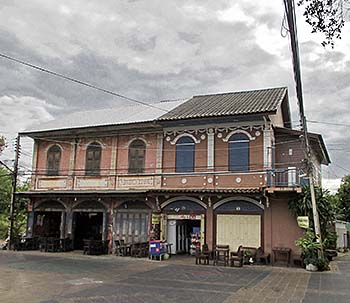
Chinese shophouses in Yasothon's town center. Image by Asienreisender, 12/2015
Yasothon has not a long history. It was probably a foundation of a noble man from the kingdom of Champasak, who was called Chao Racha Wong Singh. The founding year is given as 1811. In the failed independence war of king Anuvong of Vientiane against Siam around 1827, Yasothon was for a short time the base of the Siamese army on their way towards the Laotian capital. This army was led by Chao Phraya Bodindecha (also called Singh, lion). In 2011 a monument of him was erected near the banks of Chi River.
In the late 1820s happened the notorious forced migration of Laotians who lived on the easter side of the Mekong River to places on the western side of the grand river. That was meaned to gain Siam more control over them and to hinder further independence movements. Around estimated 100,000 people were settled in Isan, parts of them in Yasothon.
Lak Mueang
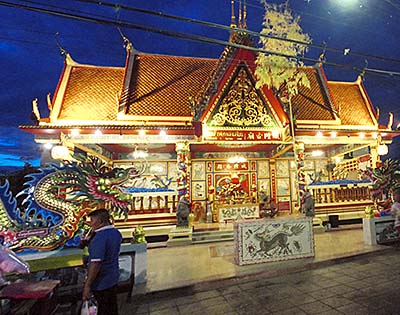
Yasothon's city pillar shrine, clearly a Chinese construction, built in 1987. Image by Asienreisender, 12/2015
In the time of the Haw wars between 1865 and 1890, Yasothon played a role supporting the Siamese army. The Haws were groups of warriors from south China who captured Luang Prabang and came further southwards.
There is a considerable Thai/Chinese influence to witness in the city center, the old town. The city pillar shrine (lak mueang) here looks rather like a Chinese temple. Another, new, wealthy and very big Chinese temple stands nearby. The few old shophouses there look very much like those colonial shophouses we see in other Southeast Asian countries who were colonialized, namely in Malacca and Georgetown/Penang. That's certainly an influence here brought in by Chinese traders who settled down here in the late 19th or early 20th century.
The establishment of Yasothon as a province happened in 1972. Before it was part of Ubon Ratchathani Province.
There is an annual rocket festival held in Yasothon in mid May, in which there is a competion in rocket launching. This obsession for fire crackers of all kinds is doubtlessly one of the downsides of Chinese customs. In 1999 it made it up into the world news for the uncontrolled explosion of a 120kg rocket caused four deaths and injured eleven more people.
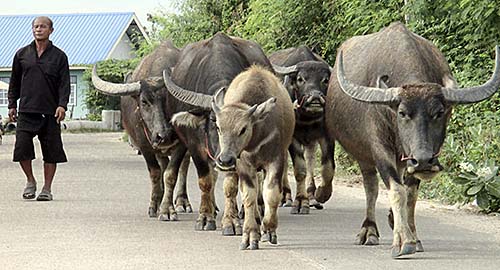
A local peasant drives his water buffalos through a sideroad of Yasothon. Image by Asienreisender, 12/2015
Between the town center and the river banks lies a Phaya Tan Park, a large area with recreation facilities, a large artificial pond and a river promenade. Also the Singh monument from 2011 is there. In daytime the park looks abandened for barely a soul is there. Moreover, the place looks like an unfinished building site.
From Yasothon bus station buses go frequently to Bangkok and other cities in Isan. Silly thing, Yasothon is one of these places were the traffic planners decided to put a new bus station three kilometers out of town. One could call this concept as 'We do our best to create people unnecessary burdens'. So, additional transport is ned, and enough motorbike drivers, nowadays licenced and dressed in an orange vest, offer their services. Alternatively are songtheaws going to and fro station and town.
Nightly City
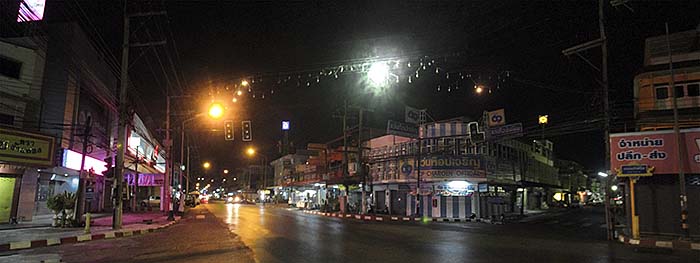
One of Yasothon's main roads, at 9pm. It's one of the quieter places, all the shops are closed now. The town's number of inhabitants is given with about 22,000, but one has to be careful with statistics... Image by Asienreisender, 12/2015
2.
The Chi River
Mae Si, as the Chi River locally is called, is the second biggest river in Isan. It's origins are in the Phetchabun Mountains, passes Yasothon and drains later into the Mun River in Si Saket Province.
As all the rivers in Southeast Asia the Chi was always a waterway. Waterways were over most of the history the much better routes than roads. Roads ned construction efforts and improvement, and were in bad states particularly in the rainy seasons. Walking over long distances is a strain, ox carts a pain and elephants were an exclusive mean of transport not for everybody. Boats therefore go smooth and can easily carry commodities and belongings.
The surroundings around Yasothon are flat, green plains through who the Chi river curves it's way slowly. There are parallel dirt roads along the river banks with very little traffic. Leaving the town, one is quickly in the countryside, surrounded by green on one side and the water on the other. Since there is very little boat traffic on the stream and not much of an industrial impact, the scenery is great and in my case I found somewhat very precious here: a deep silence, only interrupted by the occasional voice of a bird and the rippling of jumping fish from time to time.
The Chi River at Yasothon
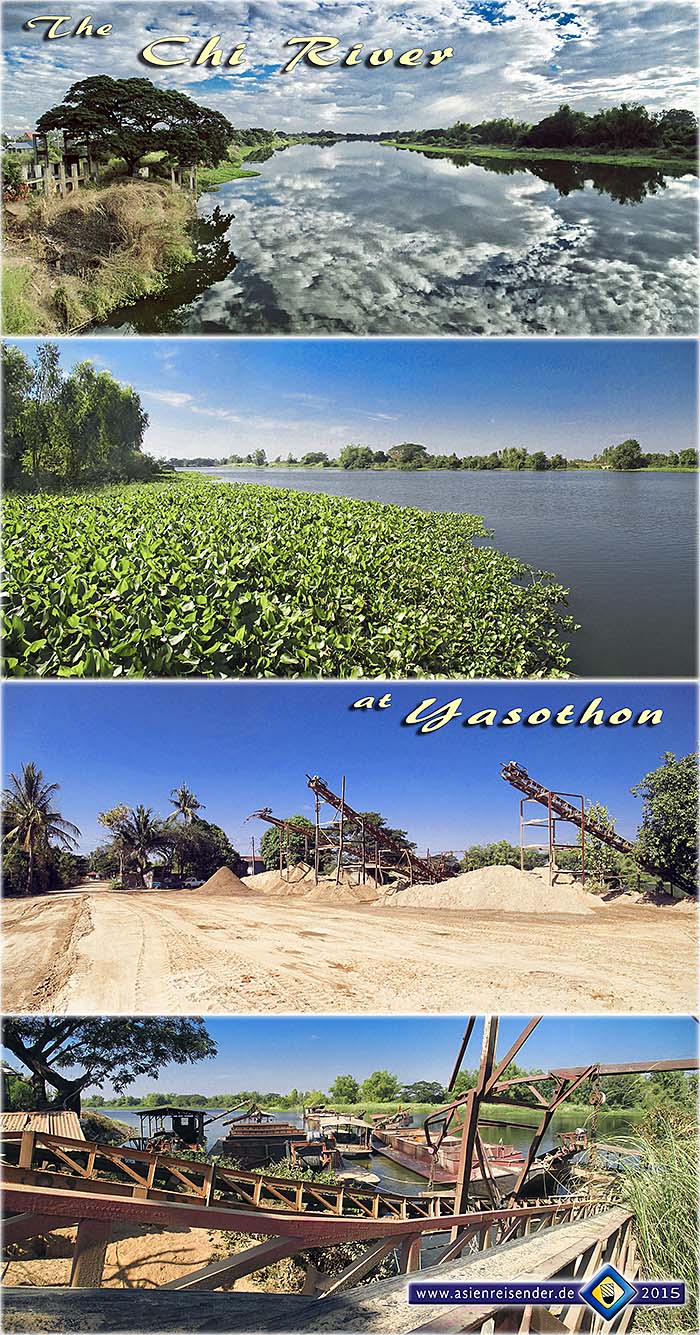
Sand is a precious resource. Southeast Asia's construction boom needs enormous amounts of sand. Any highway kilometer guzzles 30,000 tons of sand. Sand is ned for building constructions, the glass industry, the electronic industries, paper and make-up. Also the mounting of coast stripes costs sand. The expansion of Singapure into the sea is based on sand, which is by a great deal taken from the Cambodian shores. Sand dregging causes ecological devastation and economic impact on people who live in the exploited areas. Sand is running short, globally. For those who are interested I recommend the documentation 'Sand Wars' by Denis Delestrac, available at youtube.
Here the sand is probably (without knowing it in detail) used for the expansion of the ugly concrete monsters of modern cities and the expansion of the devastating roadnet. Of course it means an impact on the river's health. Although the surroundings here look surprisingly untouched, every two or so hours a large, rusty sand carrier passes to and fro.
Images and photocomposition by Asienreisender, 12/2015